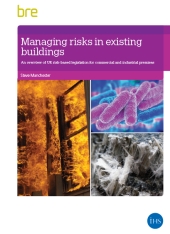Managing risks in existing buildings: An overview of UK risk-based legislation for commercial and industrial premises (FB 86)
BRE (Building Research Establishment) is an independent, research-based consultancy, testing and training organisation, operating in the built environment and associated industries.
On 30 November 2016, BRE published Managing risks in existing buildings: An overview of UK risk-based legislation for commercial and industrial premises (FB 86) by Steve Manchester.
The three main drivers for managing risks in a building or on a site are:
This guide provides an overview of issues to consider, techniques and information sources to improve the management of risks in buildings by the building owner, manager or user. This should result in reduced business losses, lower insurance premiums, improvements in operating costs, reduced absences and a reduction in reactive mitigation measures necessary after an incident.
It applies to all existing, non-domestic buildings in the UK, including; offices, warehouses, industrial/processing sites, transport hubs such as airports and railway stations, and so on. It covers risks that can have a major impact buildings, site infrastructure and occupants, such as:
- Fire.
- Explosion.
- Asbestos.
- Legionella.
- Radon.
- Noise.
- Vibration.
- Flooding.
- Contaminated land.
- Environment.
The wide-ranging nature and use of buildings means there may be some types of risk that are not covered, although the general principles for risk assessment will still apply. Risks to occupants from personal accidents such as trips, falls, manual handling and repetitive strain injuries are not covered, neither are risks from electrical or mechanical equipment in so far as they affect an individual person.
The contents of the guide include:
- Executive summary.
- Introduction.
- Hazard and risk.
- Current legislative framework.
- Analysis of specific hazards.
- Holistic benefits.
- References.
[edit] Related articles on Designing Buildings Wiki
Featured articles and news
Latest Build UK Building Safety Regime explainer published
Key elements in one short, now updated document.
UKGBC launch the UK Climate Resilience Roadmap
First guidance of its kind on direct climate impacts for the built environment and how it can adapt.
CLC Health, Safety and Wellbeing Strategy 2025
Launched by the Minister for Industry to look at fatalities on site, improving mental health and other issues.
One of the most impressive Victorian architects. Book review.
Common Assessment Standard now with building safety
New CAS update now includes mandatory building safety questions.
RTPI leader to become new CIOB Chief Executive Officer
Dr Victoria Hills MRTPI, FICE to take over after Caroline Gumble’s departure.
Social and affordable housing, a long term plan for delivery
The “Delivering a Decade of Renewal for Social and Affordable Housing” strategy sets out future path.
A change to adoptive architecture
Effects of global weather warming on architectural detailing, material choice and human interaction.
The proposed publicly owned and backed subsidiary of Homes England, to facilitate new homes.
How big is the problem and what can we do to mitigate the effects?
Overheating guidance and tools for building designers
A number of cool guides to help with the heat.
The UK's Modern Industrial Strategy: A 10 year plan
Previous consultation criticism, current key elements and general support with some persisting reservations.
Building Safety Regulator reforms
New roles, new staff and a new fast track service pave the way for a single construction regulator.
Architectural Technologist CPDs and Communications
CIAT CPD… and how you can do it!
Cooling centres and cool spaces
Managing extreme heat in cities by directing the public to places for heat stress relief and water sources.
Winter gardens: A brief history and warm variations
Extending the season with glass in different forms and terms.
Restoring Great Yarmouth's Winter Gardens
Transforming one of the least sustainable constructions imaginable.
























